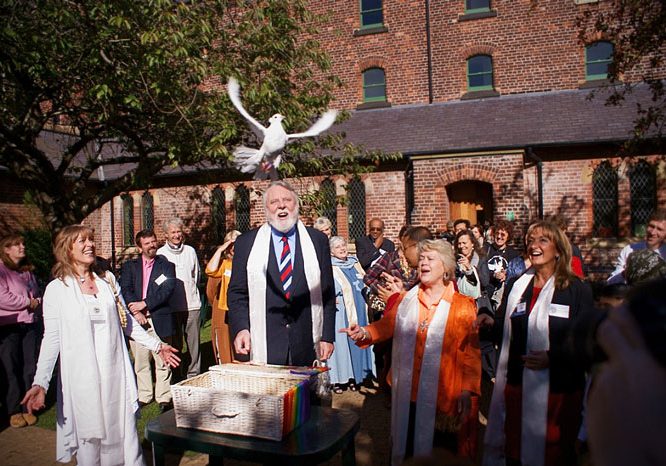
The church that rose from the dead
by Northern Life
My childhood years were spent in Cheshire in a small village where my father was the village policeman. Although the village, Styal, was only about 12 miles away from Manchester, that great city might have been in another world to those of us who were country children.
We did have a bus route that took passengers directly into Piccadilly and also a railway station complete with station master and porters! Although it was a comparatively short distance to the city we seldom went and a visit was considered to be a special outing. In those days Manchester was still recovering from the ravages of World War Two and bombed-out buildings were still in evidence. It would be a long time before new buildings took their place and the city began to look more cheerful.
Once in a while, during the school holidays, I would be taken to Belle Vue, a veritable paradise for children and for adults for that matter. At this location was the famous zoo, a fairground and also a speedway track.

Gorton Monastery
I was taken to watch motorcycles race around the cinder track and one man, who was a household name in those days, has stuck in my mind; Split Waterman. As he came to mind while I was writing this article I thought I would look him up and, sure enough, his name turned up in a few seconds on the web. He was indeed world famous for his exploits on the international speedway circuit but I got the surprise of my life when I read that following his career at Belle Vue and elsewhere he was convicted of gold smuggling and arms dealing and sentenced to a term in prison! The recorded story of his life runs out in 2011 when he was reported to be living somewhere in Spain.
Belle Vue was situated just by the district of Manchester named Gorton. This was a poor working class area and one that I never visited in my youth. Little did I know in those days that I would come to have rather a close association with this part of Manchester.
It would be stretching things too far to say that Gorton is an attractive looking location. In my youth it was full of small back to back houses and although visually not very appealing it did have a strong sense of community.
In later years, in what was fondly known as ‘regeneration’, the old houses were demolished to be replaced by buildings that while they may have provided better facilities did nothing to foster the old sense of community that used to exist there.
“The church closed and the Franciscans scattered to other parts of the world”
There was, however, one outstanding feature that was visible for miles around and that was the Church and Friary of St Francis, known by the locals as Gorton Monastery. This was the home for the Roman Catholic Community of St Francis, known universally as the Franciscans, and they came to Gorton in the mid-eighteen hundreds and participated in building this magnificent structure. It is a classic building of its kind designed by Edward Welby Pugin, son of the famous architect AWN Pugin. For years the Franciscans, known for their work among the poor, ran this church and made a considerable contribution to helping Gorton develop a strong sense of community and belonging. Alas, in 1989 everything came to a sudden halt. The church closed and the Franciscans scattered to other parts of the world leaving the building to the mercy of developers.
When I first saw it, it was in a terrible state. No developer had taken it on and so the building lay gradually sinking into deeper and deeper dereliction. It was surrounded by a protective metal fence that totally failed to protect it from vandals who robbed the building of some of its valuables and smashed what they couldn’t remove. The roof was leaking and hundreds of pigeons had sought and found sanctuary in this once beautiful building. Frankly, it was a shocking mess and a blot on the landscape.
Well, never let it be said that given courage and determination there is nothing that ordinary people can do to achieve great things.
Paul Griffiths had made his way in the world of business from humble beginnings in Gorton. As a boy he attended the Church and throughout his life carried with him positive memories of those early years. When he saw the dreadful state of the building when he revisited the site with his wife Elaine he was not only shocked, he was totally appalled. How could such a marvellous structure be allowed to sink so low? Elaine immediately rose to the challenge and together with Paul they set about the seemingly impossible task of raising over eight million pounds to make this building into a real centre of community as it had been years ago.
No longer would it be a church but would be made into a warm and welcome centre for a host of organisations and activities. I have to confess that when I first entered the derelict building my heart sank. How would it be possible to achieve Elaine’s vision? Together with Joan Bakewell I became a patron of the appeal and it is with a real sense of gratitude to Paul and Elaine and their many supporters that today the building is in the very final stages of completion.
Belle Vue as I knew it has long gone and the Monastery would have gone the same way had it not been for the vision of two very remarkable people. I do urge readers to visit Gorton and see for yourselves the transformation that has taken place. It’s living proof that with faith, vision and commitment individuals can achieve what seems to be the impossible.
